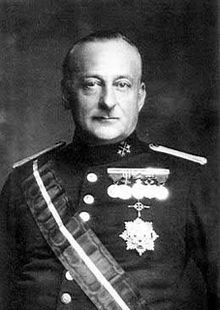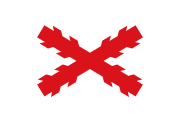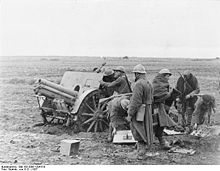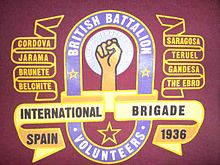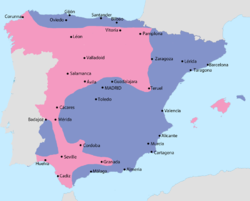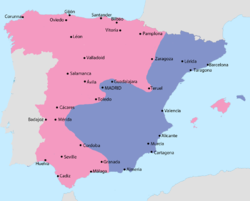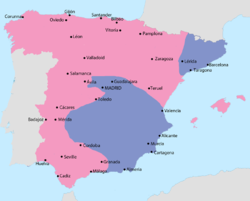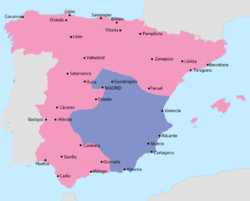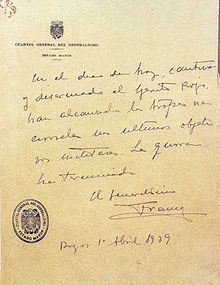- Spanish Civil War
-
Spanish Civil WarBackground
July 1936 uprising
Melilla · Seville · Barcelona · Cuartel de la Montaña · Gijón · Oviedo · Cuartel de Loyola
1936
Alcázar · Extremadura · Convoy de la victoria · Almendralejo · Sigüenza · Mérida · Badajoz · Mallorca · Sierra Guadalupe · Córdoba · Gipuzkoa · San Marcial · Monte Pelato · Talavera · Irún · Santuario de Nuestra Señora de la Cabeza · Cerro Muriano · Cape Espartel · Seseña · Madrid · Ciudad Universitaria · Corunna Road (1st) · Villarreal · Ursula · Aceituna · Lopera · Corunna Road (2nd)
1937
Corunna Road (3rd) · Málaga · Jarama · Cape Machichaco · Guadalajara · Pozoblanco · War in the North · Biscay · Guadarrama · Durango · Jaén · Guernica · Barcelona May Days · Deutschland · Almería · Segovia · Huesca · Bilbao · Albarracín · Brunete · Santander · Zaragoza · Belchite (1st) · Asturias · El Mazuco · Cape Cherchel · Sabiñánigo · Teruel
1938
Alfambra · Cape Palos · Aragón · Belchite (2nd) · Bombing of Barcelona · Caspe · Lérida · Gandesa (1st) · Segre · XYZ Line · Balaguer · Los Blázquez · Alicante · Granollers · Bielsa · Merida pocket · Ebro · Gandesa (2nd) · Cantabria · Cabra
1939
Catalonia · Valsequillo · La Garriga · Menorca · Cartagena · Olite · Final offensiveThe Spanish Civil War[nb 2] was a major conflict fought in Spain from 17 July 1936 to 1 April 1939. The war began after a pronunciamiento (declaration of opposition) by a group of conservative generals under the leadership of José Sanjurjo against the Government of the Second Spanish Republic, at the time under the leadership of President Manuel Azaña. The rebel coup was supported by a number of conservative groups including the Spanish Confederation of the Autonomous Right,[nb 3] monarchists such as the Carlists, and the Fascist Falange.[nb 4][5]
Following the only partially successful coup,[nb 5] Spain was left militarily and politically divided. From that moment onwards, conservative general Francisco Franco, began a protracted war with the established government, as loyalist supporters of the centre-left Republican Government fought the rebel forces for control of the country. The conservative generals (nacionales) received the support of Nazi Germany and the Kingdom of Italy, as well as neighbouring Portugal, while the Soviet Union and Mexico intervened in support of the Republican government.
Bloody purges occurred in pieces of territory conquered from the republic in order to consolidate Franco's future regime,[6] while similar killings took place in areas taken by the Republicans.[7] The Civil War became notable for the passion and political division it inspired. Tens of thousands of civilians on both sides were killed for their political or religious views, and after the War's conclusion in 1939, those associated with the losing Republicans were persecuted by the victorious Nationalists.
The war ended with the victory of the rebel Nationalists, the overthrow of the Republican Government, and the exile of thousands of Spanish Republicans, many of whom fled to refugee camps in Southern France. With the establishment of a conservative dictatorship led by General Francisco Franco in the aftermath of the Civil War, all right-wing parties were fused into the structure of the Franco regime.[5]
Contents
Background
Main article: Background of the Spanish Civil WarConstitutional monarchy
The century preceding Spain's Civil War was a turbulent time for the nation, which underwent several internal conflicts and revolts among the reformists and conservatives who jockeyed for control. A liberal tradition that first ascended politically with the Spanish Constitution of 1812 sought to abolish the monarchy of the old regime and to establish a more ideologically compatible state.[8] Between 1812 and the Civil War more than a century later, Liberalism's reformists attempted to realign the political system in a way that would accurately reflect Spain's societal realities.
The increasing power of liberals was felt strongly between 1868 and 1874, when a popular uprising led to the overthrowing of Isabella II.[9] Her replacement, King Amadeo I, met a similar fate when he abdicated in 1873 as the monarchy faced mounting political pressure. The First Spanish Republic was soon proclaimed, [9][10] but the restoration of the Bourbons came in December 1874 while the military quelled demonstrations.[11] While universal male suffrage was introduced in 1890, the resulting elections were dominated by caciques, local political bosses.[12] Carlists – supporters of Infante Carlos and his descendants – opposed all liberal measures, while Anarchism became popular among the Spanish working class to a degree not seen anywhere else in Europe.[8]
Prime Minister Miguel Primo de Rivera.
In the first two decades of the twentieth century, the industrial working class grew in number. There was a growing discontent amongst Basque and Catalonian people, where much of Spain's industry was based, that the government failed to represent their interests.[13] Spain's socialist party, the Spanish Socialist Workers' Party (PSOE) and its associated trade union, the Unión General de Trabajadores (UGT), gained support. A related anti-clericalism arose that was influenced by men such as republican Reformist Party founder Alejandro Lerroux, who argued that the church was inseparable from the systematic oppression felt by Spaniards.[14]
The military was keen to avoid the fracture of the state, and frowned upon regional nationalism. Resentment of the military and conscription grew with the disastrous Rif War,[15] and culminated in the confrontations of Tragic Week that followed on Barcelona's streets.[16] Animosity directed toward the military and government led to the establishment of the National Confederation of Labour (CNT), an anarchist-controlled trade union.[17] After the formation of Comintern in 1919, a growing fear of Communism emerged, and the ideology was repressed by the government through military means. The Socialist PSOE split, with more radical members founding the Communist Party in 1921.[18]
In 1923, Miguel Primo de Rivera seized power in a military coup, and governed Spain as a military dictatorship.[19] He instituted new polices, including a sweeping programme of public works, and attempted to defend the agrarian-industrial monarchist coalition formed during the First World War.[18] His support faded,[18] but following Rivera's resignation in January 1930, there was little support for a return to the pre-1923 system, and the monarchy's backing of the military government caused it to forfeit democratic credibility.[20]
The municipal elections of April 12, 1931 were little supported in major cities, and large numbers of people assembled in the streets of Madrid. King Alfonso XIII abdicated, lest he become the cause of an ensuing "fratricidal civil war."[nb 6][21] The Second Spanish Republic was formed.[22]
Second Republic
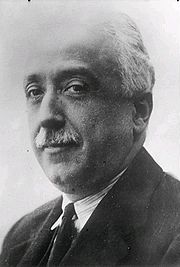 Niceto Alcalá-Zamora in 1931.
Niceto Alcalá-Zamora in 1931.
The Second Republic had the broad support of all segments of society. Republican Niceto Alcalá-Zamora was made the Prime Minister of the republic.[23] Elections to a constituent Cortes in June 1931 returned a large majority of Republicans and Socialists who formed a coalition of members with differing goals.[24] The state's financial position was poor, and an opposition composed of Catholic movements such as the Asociación Católica de Propagandistas,[nb 7][25] catastrophic monarchists including Carlists and the Renovación Española,[26] and Fascist organisations fought republican and socialist measures.[27]
Those parts of the CNT willing to cooperate with the republic were forced out while it continued to mount opposition to the government.[28] The opposition gained the support of the church [29] and military, which felt alienated by increasing regional autonomy granted by the central government, and saw governmental reforms aimed at boosting army efficiency as a direct attack. The General Military Academy in Saragossa, directed by Francisco Franco, was closed by Minister of War Manuel Azaña.[30]
On December 9, 1931, a new constitution, the Spanish Constitution of 1931, was declared.[31] The document was reformist, liberal and democratic in nature, and welcomed by the Republican-Socialist coalition. It appalled landowners, industrialists, the organised church, and army officers.[31] The 1931 constitution removed any special Catholic rights, as the new government believed it was necessary to break the control the church had over Spanish affairs.[31]
On 18 October 1931, Gil Robles the leading spokesman of the parliamentary opposition, called for a crusade against the republic.[32] In October, both Alcalá Zamora and his interior minister, Miguel Maura, resigned, and Manuel Azaña became Prime Minister. Reformist Party founder Alejandro Lerroux, who had sought Azaña's position, felt alienated and led his Radicals to join the opposition,[33] leaving the Prime Minister dependent only on the socialists.[34]
By the end of 1931, King Alfonso, in exile, ceased attempting to prevent an armed insurrection of monarchists in Spain.[35] Azaña declared that Spain had 'ceased to be Catholic'; although statistically justifiable,[nb 8] his remarks were politically unwise.[36] Spanish Catholics enlisted in the opposition.[33]
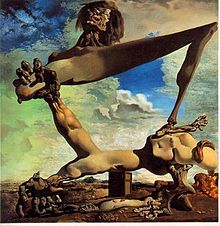 Foreshadowing the conflict: Salvador Dalí's Soft Construction with Boiled Beans (Premonition of Civil War) (1936)
Foreshadowing the conflict: Salvador Dalí's Soft Construction with Boiled Beans (Premonition of Civil War) (1936)
In August 1932, an unsuccessful uprising by General José Sanjurjo quickly disintegrated,[37] and while Socialists stood by Azaña, the left as a whole fractured, while the right coalesced.[38] Gil Robles set up a new party, the tacitly Fascist Spanish Confederation of the Autonomous Right (Spanish: Confederatión Espanola de Derechas Autónomas, CEDA) to contest the 1933 election. The poll resulted in an overwhelming victory for the right, with the CEDA and Radicals together winning 219 seats,[nb 9] and outspending the Socialists, who campaigned alone.[39]
Beginning in 1934, Spain entered a period deemed the "black two years"[40] due to the rising tension and violence before the start of the war. Radicals became more aggressive, and conservatives turned to paramilitary and vigilante actions. The Socialist opposition began to propagate a revolutionary ideal.[41] President Niceto Alcalá-Zamora declined to invite the leader of the CEDA, Gil Robles, to form a government and instead invited the Radical Republican Party's Lerroux to do so.[41] The government set about removing price controls, selling state favours and monopolies, and removing the land reforms, which resulted in growing malnourishment in the south of Spain.[42] The agrarian reforms went largely unenforced.[43]
The first anarchist protests came on 8 December 1933, and were crushed by force easily in most of Spain.[44] Both Carlists and Alfonsist monarchists prepared for fighting, the former undergoing military drills in Navarre.[43][45] Open violence occurred in the streets of Spanish cities.[46] Lerroux resigned in April 1934.[47] Parts of the Socialist Party attempted to prevent the move towards Bolshevism they saw in the movement, leading to ruptures within the party's structure.[48]
In September, Gil Robles' CEDA announced it would no longer support the Radicals' minority government; it was replaced by a Radical Party cabinet that included three members of his CEDA.[49] A mostly unsuccessful[50] UGT Socialist worker strike was followed by months of retaliation, repression and torture of political prisoners.[51] Robles once again prompted a cabinet collapse, and five members of Lerroux's new government were conceded to CEDA. Farm workers' wages were halved, and the military was purged of Republican members and reformed; those loyal to Robles were promoted – Francisco Franco was made Chief of Staff.[52]
In 1935, Azaña and Indalecio Prieto started to unify the left, staging large, popular rallies, in what would become the Popular Front.[52] Lerroux's Radical government collapsed after two large scandals, including the Straperlo affair. However, Zamora did not allow the CEDA to form a government, and called elections, which were narrowly won by the under-financed Popular Front. Figures on the right began planning to overthrow the republic.[53] The republicans were left to govern alone; Azaña led a minority government.[54] Acts of violence and reprisals spiralled,[55] and in April parliament replaced Zamora with Azaña by appealing to a constitutional technicality.[56]
CEDA turned its campaign chest over to Emilio Mola, whose organizational skills made him a formidable planner. The Fascist Falange expanded massively. Prieto did his best to avoid revolution,[57] but Communists quickly took over the ranks of socialist organisations, [57] which scared the middle classes.[58] Several generals determined that the government had to be replaced if the dissolution of Spain was to be prevented. Their actions would lead to the military coup that started the Spanish Civil War.
Military coup
Main article: Spanish coup of July 1936Preparations
The republican government had been attempting to remove suspect generals from their posts, and so Franco was sacked as chief of staff and transferred to command of the Canary islands.[59] Goded was sacked as Inspector General and made general of the Balearic islands; Emilio Mola was moved from head of the Army of Africa to be military commander of Pamplona in Navarre.[59] However, this allowed Mola to direct the mainland uprising. General José Sanjurjo became the figurehead of the operation, and helped to come to an agreement with the Carlists.[59] Mola was chief planner and second in command.[60] José Antonio Primo de Rivera was put in prison in mid-March in order to restrict the Falange.[59] However, government actions were not as thorough as they might have been: warnings by the Director of Security and other figures were not acted upon.[61]
On 12 June, Prime Minister Casares Quiroga met General Juan Yagüe, but Yagüe managed to convince Casares of his loyalty to the Republic.[62] Mola began serious planning in the spring.[60] Franco was a key player because of his prestige as a former director of the military academy and as the man who suppressed the Socialist uprising of 1934.[60] He was well respected in the Army of Africa, Spain's toughest military force.[63] He wrote a cryptic letter to Casares on 23 June, suggesting that the military was disloyal, but could be restrained if he were put in charge; Casares did nothing, failing to arrest or buy off Franco.[63] On July 5, an aircraft was chartered to take Franco from the Canary Islands to Morocco.[64] It arrived on July 14.[64]
On 12 July 1936, in Madrid, members of the Falange murdered Lieutenant José Castillo of the Assault Guards police force.[65] Castillo was a member of the Socialist party. The next day, members of the Assault Guards arrested José Calvo Sotelo, a leading Spanish monarchist and a prominent parliamentary conservative.[66] Calvo Sotelo was shot by the Guards without trial.[66] The killing of Sotelo, a prominent member of Parliament, with involvement of the police, aroused suspicions and strong reactions among the government's opponents on the right.[67][nb 10] Massive reprisals followed.[66] Although the conservative Nationalist generals were already in advanced stages of a planned uprising, the event provided a catalyst and convenient public justification for their coup.[66] The Socialists and Communists (led by Prieto) demanded that arms be distributed to the people, before the military took over. The Prime Minister was hesitant.[66] Franco's plane landed in Gran Canaria on July 14.
Beginning of the coup
 General map of the Spanish Civil War (1936–1939).
General map of the Spanish Civil War (1936–1939). Initial Nationalist zone — July 1936Nationalist advance until September 1936Nationalist advance until October 1937Nationalist advance until November 1938Nationalist advance until February 1939Last area under Republican control
Initial Nationalist zone — July 1936Nationalist advance until September 1936Nationalist advance until October 1937Nationalist advance until November 1938Nationalist advance until February 1939Last area under Republican control Main Nationalist centres
Main Nationalist centres
 Main Republican centres
Main Republican centres Land battles
Land battles
 Naval battles
Naval battles
 Bombed cities
Bombed cities
 Concentration camps
Concentration camps
 Massacres
Massacres
 Refugee camps
Refugee campsThe uprising's timing was fixed at 17 July, at 5:00 p.m.; this was agreed to by the leader of the Carlists, Manuel Fal Conde.[68] However, the timing was changed: the men in Spanish Morocco were to rise up at 5:00 a.m. and those in Spain itself starting exactly a day later, so control of Spanish Morocco could be achieved and forces sent to Iberia from Morocco to coincide with the risings there.[69] The rising was intended to be a swift coup d'état, but the government retained control of most of the country.[70]
Control in Spanish Morocco was all but certain.[71] The plan was discovered in Morocco during 17 July, which prompted it to be enacted immediately. Little resistance was encountered; in total, 189 people were shot by the rebels.[72] Goded and Franco immediately took control of the islands to which they were assigned.[60] On 18 July, Casares Quiroga refused an offer of help from the CNT and UGT, leading the groups to proclaim a general strike, in effect mobilising. They opened weapons caches, some buried since the 1934 risings.[73] The paramilitary forces often waited to see the outcome of militia action before either joining or suppressing the rebellion. Quick action by either the rebels or anarchist militias was often enough to decide the fate of a town.[74] General Queipo de Llano managed to secure Seville for the rebels, arresting a number of other officers.[75]
Outcome
The rebels failed to take any major cities with the critical exception of Seville which provided a landing point for Franco’s African troops. The primarily conservative and Catholic areas of Old Castile and León fell quickly.[70] The government retained control of Málaga, Jaén and Almería. Cadiz was taken for the rebels with the help of the first troops from the Army of Africa.[76]
In Madrid they were hemmed into the Montaña barracks, which fell with much bloodshed. Republican leader Santiago Casares Quiroga was replaced by José Giral who ordered the distribution of weapons among the civilian population.[77] This facilitated the defeat of the army insurrection in the main industrial centres, including Madrid, Barcelona, and Valencia, but it allowed the anarchists to take control of Barcelona and large swathes of Aragon and Catalonia.[78] General Goded surrendered in Barcelona and was later condemned to death.[79]
The Republican Government ended up controlling almost all of the east coast and central area around Madrid, as well as Asturias, Cantabria and part of the Basque Country in the north. Mola was keen to create a sense of fear within Nationalist-controlled areas.[80] The rebels termed themselves "Nacionales", normally translated as "Nationalists", although the former implies "true Spaniards" rather than a pure nationalistic cause.[81]
The result of the coup was a nationalist area of control containing 11 million of Spain's population of 25 million.[82] The Nationalists had secured the support of around half of Spain's territorial army, some 60,000 men, joined by the Army of Africa, made up of 35,000 men,[83] and a little under half of Spain's militaristic police forces, the Assault Guards, the Civil Guards, and the Carabineers.[84] Republicans controlled under half of rifles, and about a third of both machine guns and artillery pieces.[83][85]
The Spanish Army had just 18 tanks of a sufficiently modern design, and the Republicans retained 10.[86] Naval capacity was fairly even, with the Republicans retaining a numerical advantage but with the Navy's top ships in Nationalist hands. The Republican navy suffered from the same problems as the army: many officers had defected or had been killed after trying to do so.[86] Two-thirds of air capability was retained by the government – however, the whole of the air service was very outdated.[87]
Combatants
The war was cast by Republican sympathizers as a struggle between "tyranny and democracy", and by Nationalist supporters as between communist and anarchist "red hordes" and "Christian civilization".[88] Nationalists also claimed to be protecting the establishment and bringing security and direction to an ungoverned and lawless society.[88]
Spanish politics, especially on the left, was quite fragmented, as socialists and communists supported the Republic. During the Republic, anarchists had had mixed opinions, but major groups opposed the Nationalists during the Civil War. The Conservatives, by contrast, were united by their fervent opposition to the Republican government, and presented a more unified front.[89]
Republicans
Main article: Republican faction (Spanish Civil War)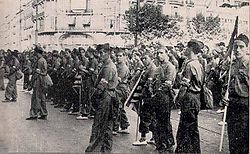 Republican volunteers at Teruel, 1936.
Republican volunteers at Teruel, 1936.
The Republicans (also known as Spanish loyalists) received weapons and volunteers from the Soviet Union, Mexico, the international Marxists movement and International Brigades. Their supporters ranged from centrists who supported a moderately capitalist liberal democracy to revolutionary anarchists; their base was primarily secular and urban, but also included landless peasants, and was particularly strong in industrial regions like Asturias and Catalonia.[90]
This faction was called variously the "loyalists" by its supporters; the "Republicans", "the Popular Front" or "the Government" by all parties, while its enemies referred to Republicans as "the reds".[91] Republicans were supported by most urban workers, a large share of peasants, and much of the educated middle class.
The conservative, strongly Catholic Basque country, along with Galicia and the more left-leaning Catalonia, sought autonomy or even independence from the central government of Madrid. The Republican government allowed for the possibility of self-government for the two regions,[92] whose forces were gathered under the People's Republican Army (Ejército Popular Republicano, or EPR).
Nationalists
Main article: National faction (Spanish Civil War)The Nationalists (nacionales), (also called "insurgents", "rebels" or by opponents "Francoists" or "Fascists") fearing national fragmentation, opposed the separatist movements, and were chiefly defined by their anti-communism, which galvanized diverse or opposed movements like falangists and monarchists. Their leaders had a generally wealthier, more conservative, monarchist, landowning background.[93]
The Nationalist side included the Carlists and Alfonsist monarchists, Spanish nationalists, the fascist Falange, and most conservatives and monarchist liberals. Virtually all Nationalist groups had strong Catholic convictions and supported the native Spanish clergy.[93] The Nationals included the majority of the Catholic clergy and practitioners (outside of the Basque region), important elements of the army, most large landowners, and many businessmen.[88]
One of the rightists' principal stated motives was to confront the anti-clericalism of the Republican regime and to defend the Church,[93] which had been the targeted by opponents, including Republicans who blamed the institution for the country's ills. Prior to the war, in the Asturias uprising of 1934, religious buildings were burnt and at least one hundred clergy, religious civilians, and police were killed by revolutionaries against whom the president and the radicals prevented the implementation of serious sanctions or punishment.[94][95]
Articles 24 and 26 of the Constitution of Spain's Republic had banned the Jesuits, which deeply offended many within the conservative fold. The revolution in the Republican zone at the outset of the war, killing 7,000 clergy and thousands of lay people, drove many Catholics to the Nationalist faction.[96][97]
Other factions
Catalan and Basque nationalists were not univocal. Left-wing Catalan nationalists sided with the Republicans, while Conservative Catalan nationalists were far less vocal supporting the government due to anti-clericalism and confiscations occurring in areas within its control. Basque nationalists, heralded by the conservative Basque Nationalist Party, were mildly supportive of the Republican government, even though some in Navarre sided with the uprising for the same reasons influencing conservative Catalans. Notwithstanding religious matters, Basque nationalists, who were for the most part Catholic, generally sided with the Republicans.[98]
Foreign involvement
Main article: Foreign involvement in the Spanish Civil WarThe Spanish Civil War involved large numbers of non-Spanish citizens who participated in combat and advisory positions. Germany and Italy contributed large amounts of financial assistance and military aid to forces led by Franco. Forces fighting on behalf of the Republican faction also received support, but the Republic's allies were seriously hampered by the non-intervention proclaimed by France and the United Kingdom. The attempted suppression of imported materials was largely ineffective, however, and France especially was accused of allowing large shipments to Republican troops.[99] The clandestine actions of the various European powers were at the time considered to be risking another 'Great War'.[100]
The League of Nations' reaction to the war was mostly neutral and insufficient to contain the massive importation by fighting factions of arms and other war resources. Although a Non-Intervention Committee was formed, its policies accomplished little, and its directives were dismantled due to the policies of appeasement practised by European states; the official Spanish government of Juan Negrín was gradually abandoned within the organization during this period.[101]
Support for the Nationalists
Germany
Main article: German involvement in the Spanish Civil War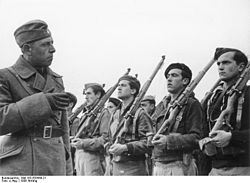 Members of the Condor Legion.
Members of the Condor Legion.
Despite the German signing of a non-intervention agreement in September 1936, various forms of aid and military help from Germany found their way to both sides of the Spanish conflict, largely in support of the Nationalist faction. Nazi actions included the formation of the multitasking Condor Legion, while German efforts to move the Army of Africa to mainland Spain proved successful in the war's early stages.[102] German operations slowly expanded to include strike targets, most notably —and controversially— the bombing of Guernica, which on 26 April 1937 killed 200 to 300 civilians.[103]
German involvement was further manifested through undertakings such as Operation Ursula, a U-boat undertaking, and contributions from the Kriegsmarine. The Legion spearheaded many Nationalist victories, particularly in aerial combat,[104] while Spain further provided a proving ground for German tank tactics. The training German units provided to Nationalist force would prove valuable; by the War's end, perhaps fifty-six thousand Nationalist soldiers encompassing infantry, artillery, aerial and naval forces had been trained by German detachments.[102]
Probably a total of 16,000 German citizens fought in the War, including approximately 300 killed,[105] though no more than ten thousand participated at any one time. German aid to the Nationalists amounted to approximately £43,000,000 ($215,000,000) in 1939 prices,[105][nb 11] 15.5% of which was used for salaries and expenses and 21.9% for direct delivery of supplies to Spain, while 62.6% was expended on the Condor Legion.[105]
Italy
After Francisco Franco’s request and encouragement by Adolf Hitler, Benito Mussolini joined the war. While the conquest of Abyssinia had made Italy delirious with power, a Spanish ally would help secure Italian control of the Mediterranean.[106] The Royal Italian Navy (Regia Marina Italiana) played a substantial role in the Mediterranean blockade and ultimately Italy supplied machine guns, artillery, aircraft, tankettes, the Legionary Air Force (Italian: Aviazione Legionaria), and the Corps of Volunteer Troops (Italian: Corpo Truppe Volontarie, or CTV) to the Nationalist cause.[107] The Italian CTV would at its peak supply the Nationalists with 50,000 men.[108]
Portugal
António de Oliveira Salazar's Estado Novo played an important role in supplying Franco’s forces with ammunition and logistical help.[109] Despite its discreet direct military involvement — restrained to a somewhat "semi-official" endorsement, by its authoritarian regime, of a volunteer force of up to 20,000,[110][111] so-called "Viriatos" — for the whole duration of the conflict, Portugal was instrumental in providing the Nationalists with organizational skills and reassurance from the Iberian neighbor to Franco and his allies that no interference would hinder the supply traffic directed to the Nationalist cause.[112]
Others
Despite the Irish government's prohibition against participating in the war, around six hundred Irishmen, followers of Eoin O'Duffy known as the "Irish Brigade", went to Spain to fight alongside Franco.[110] Romanian volunteers were led by Ion I Moţa, deputy-leader of the Legion of the Archangel Michael (or Iron Guard), whose group of seven Legionaries visited Spain in December 1936 to ally their movement with the Nationalists.[113]
Support for the Republicans
International Brigades
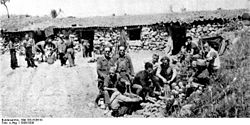 The Etkar André battalion of the International Brigades.
The Etkar André battalion of the International Brigades.
Many non-Spaniards, often affiliated with radical communist or socialist entities, joined the International Brigades, believing that the Spanish Republic was a front line in the war against fascism. The units represented the largest foreign contingent of those fighting for the Republicans. Roughly forty thousand foreign nationals fought with the Brigades, though no more than 18,000 were entered into the conflict at any given time; they claimed to represent 53 states.[114]
Significant numbers of volunteers originated in France (10,000), Germany and Austria (5,000) and Italy (3,350). More than 1,000 came from the USSR, United States, United Kingdom, Poland, Yugoslavia, Hungary and Canada.[114] The Thälmann Battalion, a group of Germans, and the Garibaldi Battalion, a group of Italians, distinguished their unit during the Siege of Madrid. Americans fought in units such as the Abraham Lincoln Brigade, while Canadians joined the Mackenzie-Papineau Battalion.[115]
Over five hundred Romanians fought on the Republican side, including Romanian Communist Party members Petre Borilă and Valter Roman.[116] About 80 volunteers from Ireland formed the Connolly Column, the latter of which was immortalized by Irish folk singer Christy Moore in the song 'Viva La Quinta Brigada.' Some Chinese joined the Brigades, the majority of which returned to China, while some went to prison or French refugee camps, and a handful remained in Spain.[117]
Soviet Union
The Soviet Union primarily provided material assistance to the Republican forces. In total the USSR provided the leftists with 806 planes, 362 tanks, and 1,555 artillery pieces.[118] The Soviet Union ignored the League of Nations embargo and sold arms to the Republic when few other nations would do so; it was therefore the Republic's only source of major weapons. Stalin had signed the Non-Intervention Agreement but decided to break the pact, though he tried doing so secretly, unlike Hitler and Mussolini.[119]
The Soviet premier created a section X of the Soviet Union military to head the weapons shipment operation, coined Operation X. Despite Stalin's interest in aiding the Republicans, however, most of the weapons and artillery sent to Spain were relics, some captured from past conflicts.[120] Occasionally, modern weapons such as BT-5 tanks were sent.[121]
Many of the Soviet deliveries were lost, due to short notice on orders, or arrived only partially matching what Stalin had authorised.[122] When the ships left with supplies for the Republican cause, their journeys were extremely slow. Stalin ordered the builders to include false decks in the original designs of boats. Furthermore, once the sea vessels left shore, the Soviets were required to change flags and boat colors to minimize capture by the Nationalists.[123] Such manoeuvres become unnecessary in 1938, however, when Stalin withdrew his troops and tanks as government ranks floundered. The Republican-Soviet alliance was an uneasy affair, and had the Spanish leftists had the opportunity to buy transport and weapons from alternative sources, they may have cut ties with Moscow.[124]
The Republic was obligated to pay for Soviet arms with official Bank of Spain gold reserves, in an affair that would become a frequent subject of Francoist propaganda, under the term "Moscow Gold". The cost to the Republic of Soviet arms was more than US $500 million (in 1936 prices); the entire of Spain's gold reserve, the fourth-largest in the world.[125] 176 tonnes was transferred through France.[125]
The USSR further sent a number of military advisers to Spain (2,000[126]–3,000[127]),[128] and while Soviet troops amounted to no more than 500 men at a time, Soviet volunteers often operated Soviet-made Republican tanks and aircraft, particularly at the beginning of the war.[114] In addition, the Soviet Union directed Communist parties around the world to organize and recruit the International Brigades. Another significant Soviet involvement were the pervasive activities of the NKVD spanning the Republican rearguard. Communist figures like Vittorio Vidali ("Comandante Contreras"), Iosif Grigulevich and, most prominently, Alexander Orlov led "secret" operations that included murders like those of Andreu Nin[129] and José Robles.[130]
Mexico
Unlike the United States and major Latin American governments such as the ABC Powers and Peru, the Mexican government supported the Republicans.[131][132] Mexico refused to follow the French-British non-intervention proposals,[131] furnishing $2,000,000 in aid and material assistance, which included 20,000 rifles and 20 million cartridges.[131]
Mexico's most important contributions to the Spanish Republic were its diplomatic help, as well as the sanctuary the nation arranged for Republican refugees, including Spanish intellectuals and orphaned children from Republican families. Some 50,000 took refuge, primarily in Mexico City, accompanied by $300 million in various treasures still owned by the Left.[133]
Course of the war
1936
Main article: Spanish Civil War chronology 1936A large air and sea-lift of Nationalist troops in Spanish Morocco was organised to the south-west of Spain.[134] Coup leader Sanjurjo was killed in a plane crash on 20 July,[135][136] leaving an effective command split between Mola in the North and Franco in the South.[60] This period also saw the worst actions of the so-called "Red" and "White" "Terrors" in Spain.[137][138] On 21 July, the fifth day of the rebellion, the Nationalists captured the central Spanish naval base, located in Ferrol in north-western Spain.[139]
A rebel force under Colonel Beorlegui Canet, sent by General Mola, undertook the Campaign of Gipuzkoa from July to September. The capture of Gipuzkoa isolated the Republican provinces in the north. On 5 September, after heavy fighting the force took Irún, closing the French border to the Republicans.[140] On 15 September, San Sebastián, home to a divided Republican force of anarchists and Basque nationalists, was taken by Nationalist soldiers.[141] The Nationalists then advanced toward their capital, Bilbao, but were halted by Republican militias on the border of Biscay at the end of September.
The Republican government under Giral resigned on 4 September, unable to cope with the situation in which it found itself, and was replaced by a mostly Socialist organization under Largo Caballero.[142] The new leadership began to unify central command in the republican zone.[143] On the Nationalist side, Franco was chosen as chief military commander at a meeting of ranking generals at Salamanca on 21 September, now called by the title Generalísimo.[60][144]
Franco won another victory on 27 September when his troops relieved the Alcázar in Toledo[144] that had been held by a Nationalist garrison under Colonel Moscardo since the beginning of the rebellion, resisting thousands of Republican troops who totally surrounded the isolated building. Two days after relieving the siege, Franco proclaimed himself Caudillo ("chieftain"), while forcibly unifying the various and diverse Falangist, Royalist and other elements within the Nationalist cause.[142] The diversion to Toledo gave Madrid time to prepare a defense, but was hailed as a major propaganda victory and personal success for Franco.[145]
In October, the Francoist troops launched a major offensive toward Madrid,[146] reaching it in early November and launching a major assault on the city on 8 November.[147] The Republican government was forced to shift from Madrid to Valencia, outside the combat zone, on 6 November.[148] However, the Nationalists' attack on the capital was repulsed in fierce fighting between 8 November and 23 November. A contributory factor in the successful Republican defense was the arrival of the International Brigades, though only an approximate three thousand foreign volunteers participated in the battle.[149] Having failed to take the capital, Franco bombarded it from the air and, in the following two years, mounted several offensives to try to encircle Madrid. The battle of the Corunna Road, a Nationalist offensive to the north-west, pushed Republican forces back, but failed to isolate Madrid. The city lasted into January.[150]
1937
Main article: Spanish Civil War chronology 1937With his ranks swelled by Italian troops and Spanish colonial soldiers from Morocco, Franco made another attempt to capture Madrid in January and February 1937, but was again unsuccessful. The Battle of Málaga started in mid-January; this Nationalist offensive in Spain's south-east would turn into a disaster for the Republicans, who were poorly organised and armed. The city was taken by Franco on 8 February.[151] The consolidation of various militias into the Republican Army had started in December 1936.[152] The main Nationalist advance, to cross the Jarama river and cut the supply of Madrid by the Valencia road, termed the Battle of Jarama, led to heavy casualties (6–20,000) on both sides. The operation's main objective was not met, though Nationalists gained a modest amount of territory.[153]
A similar Nationalist offensive, the Battle of Guadalajara, was a more significant defeat for Franco and his armies; it proved the only publicised Republican victory of the war. Italian troops and blitzkrieg tactics were used by Franco, and while many strategists blamed the latter for the rightists' defeat, the Germans believed it was the former at fault for the Nationalists' 5,000 casualties and loss of valuable equipment.[154] The German strategists successfully argued that the Nationalists needed to concentrate on vulnerable areas first.[155]
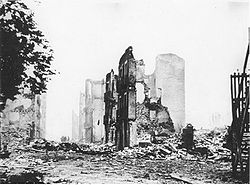 Ruins of Guernica.
Ruins of Guernica.
The "War in the North" began in mid-March,[156] with Biscay as a first target.[157] The Basques suffered most from the lack of a suitable air force;[158] on 26 April, the Condor Legion bombed the town of Guernica, killing two to three hundred. The destruction had a significant effect on international opinion.[159] The Basques retreated.[160]
April and May saw infighting among Republican groups in Catalonia. The dispute was between an ultimately victorious government–Communist force and the anarchist CNT. The disturbance pleased Nationalist command, but little was done to exploit Republican divisions.[161] After the fall of Guernica, the Republican government began to fight back with increasing effectiveness. In July, it made a move to recapture Segovia, forcing Franco to delay his advance on the Bilbao front, but for only two weeks. A similar Republican attack on Huesca failed similarly.[162]
Mola, Franco's second-in-command, was killed on 3 June.[163] In early July, despite the earlier fall in June of Bilbao, the government launched a strong counter-offensive to the west of Madrid, focusing on Brunete. The Battle of Brunete, however, was a significant defeat for the Republic, which lost many of its most accomplished troops. The offensive had led to an advance of 50 square kilometres (19 sq mi), and left 25,000 Republican casualties.[164]
A Republican offensive against Zaragoza was also a failure. Despite having land and aerial advantages, the Battle of Belchite resulted in an advance of only ten kilometres and the loss of much equipment.[165] Franco invaded Aragón in August and then took the city of Santander.[166] With the surrender of the Republican army in the Basque territory came the Santoña Agreement;[167] Gijón finally fell in late October.[168] Franco had effectively won in the north. At November's end, with Franco's troops closing in on Valencia, the government had to move again, this time to Barcelona.[169]
1938
Main article: Spanish Civil War chronology 1938–1939The Battle of Teruel was an important confrontation. The city, which had formerly belonged to the Nationalists, was conquered by Republicans in January. The Francoist troops launched an offensive and recovered the city by 22 February, but Franco was forced to rely heavily on German and Italian air support.[170]
On 7 March, Nationalists launched the Aragon Offensive, and by 14 April, they had pushed through to the Mediterranean, cutting the Republican-held portion of Spain in two. The Republican government attempted suing for peace in May,[171] but Franco demanded unconditional surrender; the war raged on. In July, the Nationalist army pressed southward from Teruel and south along the coast toward the capital of the Republic at Valencia, but was halted in heavy fighting along the XYZ Line, a system of fortifications defending Valencia.[172]
The Republican government then launched an all-out campaign to reconnect their territory in the Battle of the Ebro, from 24 July until 26 November.[173] The campaign was unsuccessful, and was undermined by the Franco-British appeasement of Hitler in Munich. The agreement with Britain effectively destroyed Republican morale by ending hope of an anti-fascist alliance with Western powers.[174] The retreat from the Ebro all but determined the final outcome of the war.[173] Eight days before the new year, Franco threw massive forces into an invasion of Catalonia.[175]
1939
Main article: Spanish Civil War chronology 1938–1939Franco's troops conquered Catalonia in a whirlwind campaign during the first two months of 1939. Tarragona fell on 15 January,[176] followed by Barcelona on 26 January[177] and Gerona on 2 February.[178] On 27 February, the United Kingdom and France recognized the Franco regime.[179]
Only Madrid and a few other strongholds remained for the Republican forces. On 28 March, with the help of pro-Franco forces inside the city, Madrid fell to the Nationalists.[180] The next day, Valencia, which had held out from Nationalists for close to two years, also surrendered. Franco proclaimed victory in a radio speech aired on 1 April, when the last of the Republican forces surrendered.
After the end of the War, there were harsh reprisals against Franco's former enemies;[181] thousands of Republicans were imprisoned and at least 30,000 executed.[182] Other calculations of these deaths range from 50,000[183] to 200,000 depending on which killings are included.Many others were put to forced labour, building railways, drying out swamps, and digging canals.[183]
Hundreds of thousands of Republicans fled abroad, some 500,000 to France.[184] Refugees were confined in internment camps of the French Third Republic, such as Camp Gurs or Camp Vernet, where twelve thousand Republicans were housed in squalid conditions. Of the 17,000 refugees housed in Gurs, farmers and others who could not find relations in France were encouraged by the Third Republic, in agreement with the Francoist government, to return to Spain. The great majority did so and were turned over to the Francoist authorities in Irún.[185]
From there they were transferred to the Miranda de Ebro camp for "purification" according to the Law of Political Responsibilities. After the proclamation by Marshal Philippe Pétain of the Vichy regime, the refugees became political prisoners, and the French police attempted to round up those who had been liberated from the camp. Along with other "undesirables", the Spaniards were sent to the Drancy internment camp before being deported to Nazi Germany. About 5,000 Spaniards thus died in the Mauthausen concentration camp.[185]
After the official end of the war, guerrilla war was waged on an irregular basis by the Spanish Maquis well into the 1950s, being gradually reduced by military defeats and scant support from the exhausted population. In 1944, a group of republican veterans, who also fought in the French resistance against the Nazis, invaded the Val d'Aran in northwest Catalonia, but were defeated after ten days.[186]
Evacuation of children
Main article: Evacuation of children in the Spanish Civil War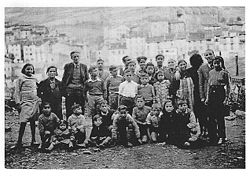 Residents of the War Resisters' International (WRI) children's refuge in the French Pyrenees, some time between 1937 and 1939, warden José Brocca standing third from left.
Residents of the War Resisters' International (WRI) children's refuge in the French Pyrenees, some time between 1937 and 1939, warden José Brocca standing third from left.
The Republicans oversaw the evacuation of 30–35,000 children from their zone.[187] This started with Basque areas, from which 20,000 were evacuated. Their destinations included the United Kingdom[188] and the USSR, and many other locations in Europe, along with Mexico.[187] Around 4,000 were taken to the UK against initial opposition from both the government and charitable groups who saw the removal of children from their native country as potentially harmful. The upper age limit was initially set at 12 but raised to 15.[189]
Atrocities
Death totals remain debated. Antony Beevor writes in his history of the Civil War that Franco's ensuing 'white terror' resulted in the deaths of 200,000 people and that the 'red terror' killed 38,000.[190] Julius Ruiz contends that "although the figures remain disputed, a minimum of 37,843 executions were carried out in the Republican zone with a maximum of 150,000 executions (including 50,000 after the war) in Nationalist Spain".[191]
In 2008 a Spanish judge, Baltasar Garzón, opened an investigation into the executions and disappearances of 114,266 people between 17 July 1936 and December 1951 (Garzón has since been indicted for violating a 1977 amnesty law through his actions). Among the executions investigated was that of the poet and dramatist Federico García Lorca;[3] mention of his death was forbidden during Franco's regime.[192]
Nationalists
See also: White Terror (Spain)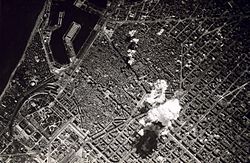 Bombing in Barcelona, 1938.
Bombing in Barcelona, 1938.
Atrocities of the Nationalists, frequently ordered by authorities in order to eradicate any trace of leftism in Spain, were common. According to historian Paul Preston, the minimum number of those executed by the rebels is 130,000,[193] and is likely to have been far higher.[194] The violence carried out in the rebel zone was carried out by the military, the Civil Guard and the Falange in the name of the regime and legitimized by the Catholic Church.[195]
Many such acts were committed by reactionary groups during the first weeks of the war.[195] This included the execution of school teachers,[196] because the efforts of the Second Spanish Republic to promote laicism and displace the Church from schools by closing religious educational institutions were considered by the Nationalists as an attack on the Roman Catholic Church. Extensive killings of civilians were carried out in the cities Nationalists captured, [197] along with the execution of unwanted individuals. These included non-combatants such as trade-unionists, Popular Front politicians, suspected Freemasons, Basque, Catalan, Andalusian and Galician Nationalists, Republican intellectuals, relatives of known Republicans and those suspected of voting for the Popular Front.[195][198][199][200][201]
Nationalist forces massacred civilians in Seville, where some 8,000 people were shot; ten thousand were killed in Cordoba. 6–12,000 were killed in Badajoz.[202] In Granada, at least 2000 people were murdered.[196] In February 1937, over seven thousand were killed after the capture of Málaga.[203] When Bilbao was conquered thousands of people were sent to prison; there were fewer executions than usual, however, because of the effect Guernica left on Nationalists' reputations internationally.[204] The numbers killed as the successful columns of the Army of Africa devastated and pillaged their way between Seville and Madrid are particularly difficult to calculate.[205]
Nationalists also murdered Catholic clerics. In one particular incident, following the capture of Bilbao, hundreds of people, including 16 priests who had served as chaplains for the Republican forces, were taken to the countryside or graveyards to be murdered.[206][207]
Franco's forces also persecuted Protestants, including the murder of twenty Protestant ministers.[208] Franco's forces were determined to remove the "Protestant heresy" from Spain.[209] The Nationalists also persecuted Basques, as they strived to eradicate Basque culture.[166] According to Basque sources, some 22,000 Basques were murdered by Nationalists immediately after the Civil War.[210]
The Nationalist side also conducted aerial bombing of cities in Republican territory, carried out mainly by the Luftwaffe volunteers of the Condor Legion and the Italian air force volunteers of the Corpo Truppe Volontarie, Madrid, Barcelona, Valencia, Guernica, Durango and other cities were targeted, the Bombing of Guernica was among the most controversial.[211]
Republicans
See also: Red Terror (Spain) "Execution" of the Sacred Heart of Jesus by Communist militiamen. The photograph in the London Daily Mail had the caption the "Spanish Reds' war on religion."[212]
"Execution" of the Sacred Heart of Jesus by Communist militiamen. The photograph in the London Daily Mail had the caption the "Spanish Reds' war on religion."[212]
 The Puente Nuevo bridge. Both Nationalists and Republicans are claimed to have thrown prisoners from the bridge to their deaths in the canyon.[213]
The Puente Nuevo bridge. Both Nationalists and Republicans are claimed to have thrown prisoners from the bridge to their deaths in the canyon.[213]
According to the Nationalists, an estimated 55,000 civilians died in Republican-held territories. This is considered excessive by Antony Beevor; however, it was much less than the half a million claimed during the war.[214] The deaths would form the prevailing outside opinion of the Republic up until the bombing of Guernica.[214]
The Republican government was anticlerical, and supporters attacked and murdered Roman Catholic clergy in reaction to news of military revolt.[215] In Republican held territories, Roman Catholic churches were desecrated. Through the war, nearly all segments of the Republicans, Basques being a notable exception, took part in semi-organized anti-Roman Catholic killing of 6,832 members of Catholic clergy and religious orders (including 13 bishops, 4,184 priests, 2,365 monks and friars, and 283 nuns).[208][216]
The "Execution" of the Sacred Heart of Jesus by Communist militiamen at Cerro de los Ángeles near Madrid, on 7 August 1936, was the most infamous of widespread desecration of religious property.[217] By the conflict's end 20 percent of the nation's clergy had been killed,[218] though some argue the totals were lower.[nb 12]
Like clergy, civilians were executed in Republican territories. Some civilians were executed as suspected Falangists.[219] Others died in acts of revenge after Republicans heard of massacres carried out in the Nationalist zone.[220] Air raids committed against Republican cities were another driving factor.[221] Republican authorities did not order such measures to be taken.[222] Shopkeepers and industrialists, if rightist collaborators, were shot; if they were well regarded for their attitude to the poor, they were usually spared.[223] Fake justice was sought though commission, known by its name in Russia as checas.[224]
As pressure mounted with increasing success of the Nationalists, many civilians were executed by councils and tribunals controlled by competing Communist and Anarchist groups.[224] Some members of the latter were executed by Soviet-advised communist functionaries in Catalonia,[213] as described by George Orwell's description of the purges in Barcelona in 1937 in Homage to Catalonia, which followed a period of increasing tension between Competing elements of the Catalan political scene. Some individuals fled to friendly embassies, which would house up to 8,500 people during the war.[225]
In the Andalusian town of Ronda, 512 alleged Nationalists were executed in the first month of the war.[213] Communist Santiago Carrillo Solares has been accused of the killing of Nationalists in the Paracuellos massacre near Paracuellos del Jarama.[226] Pro-Soviet Communists committed numerous atrocities against fellow Republicans, including other Marxists: André Marty, known as the Butcher of Albacete, was responsible for the deaths of some 500 members of the International Brigades.[227] Andreu Nin, leader of the POUM (Workers' Party of Marxist Unification), and many other prominent POUM members, were murdered by the Communists, with the help of the USSR's NKVD.[228]
Thirty eight thousand people were killed in the Republican zone during the war, 17,000 of whom were killed in Madrid or Catalonia within a month of the coup. Whilst the Communists were forthright in their support of extrajudicial killings, much of the Republican side was appalled by the murders.[229] Azaña came close to resigning.[225] He, alongside other members of parliament and a great number of other local officials, attempted to prevent Nationalist supporters being lynched. Some of those in positions of power intervened personally to stop the killings.[229]
Social revolution
Main article: Spanish RevolutionIn the anarchist-controlled areas, Aragón and Catalonia, in addition to the temporary military success, there was a vast social revolution in which the workers and peasants collectivised land and industry, and set up councils parallel to the paralyzed Republican government.[230] This revolution was opposed by both the Soviet-supported communists who, perhaps surprisingly, campaigned against the loss of civil property rights.[230] The agrarian collectives had considerable success despite opposition and lack of resources.[231]
As the war progressed, the government and the communists were able to leverage their access to Soviet arms to restore government control over the war effort, through both diplomacy and force.[232] Anarchists and the Workers' Party of Marxist Unification (Partido Obrero de Unificación Marxista, POUM) were integrated into the regular army, albeit with resistance; the POUM was outlawed and falsely denounced as an instrument of the fascists.[232] In the May Days of 1937, many thousands of anarchist and communist Republican soldiers fought for control of strategic points in Barcelona.[233]
The pre-war Falange was a small party of some 30–40,000 members.[234] It also called for a social revolution that would have seen Spanish society transformed by National Syndicalism.[235] Following the execution of its leader, José Antonio Primo de Rivera, by the Republicans, the party swelled in size to several hundred thousand members.[236] The leadership of the Falange suffered 60% casualties in the early days of the civil war and the party was transformed by new members and rising new leaders, called camisas nuevas ("new shirts"), who were less interested in the revolutionary aspects of National Syndicalism.[237] Subsequently, Franco united all rightist parties into the Traditionalist Spanish Falange and the National Syndicalist Offensive Juntas (Spanish: Falange Española Tradicionalista de las Juntas de Ofensiva Nacional-Sindicalista, FET y de las JONS).[238]
The 1930s also saw Spain become a focus for pacifist organizations including the Fellowship of Reconciliation, the War Resisters League and the War Resisters' International. Many people including, as they are now called, the 'insumisos' ('defiant ones', conscientious objectors) argued and worked for non-violent strategies. Prominent Spanish pacifists such as Amparo Poch y Gascón and José Brocca supported the Republicans. Brocca argued that Spanish pacifists had no alternative but to make a stand against fascism. He put this stand into practice by various means including organizing agricultural workers to maintain food supplies and through humanitarian work with war refugees.[nb 13]
People
See also: List of people of the Spanish Civil WarFigures identified with the Nationalist side
- Military
- Francisco Franco (Spain)
- Miguel Cabanellas (Spain)
- José Sanjurjo (Spain)
- Emilio Mola (Spain)
- Gonzalo Queipo de Llano (Spain)
- Juan Yagüe (Spain)
- Hugo Sperrle (Germany)
- Wilhelm Ritter von Thoma (Germany)
- Wolfram Freiherr von Richthofen (Germany)
- Mario Roatta (Italy)
- Ettore Bastico (Italy)
- Non-military
- Salvador Dalí
- Pedro Muñoz Seca (assassinated)
- Ramón Serrano Súñer
- Miguel Delibes
Figures identified with the Republican side
- Politicians or military
- Manuel Azaña (Republican)
- Santiago Carrillo (Communist)
- Valentin González ("El Campesino") (Communist)
- Dolores Ibarruri ("La Pasionaria") (Communist)
- Francisco Largo Caballero (Socialist)
- Diego Martínez Barrio (Republican)
- Juan Negrín (Socialist)
- Andrés Nin (Communist)
- Indalecio Prieto (Socialist)
- Buenaventura Durruti (Anarchist)
- Others (including volunteers)
Political parties and organizations
Political parties and organizations in the Spanish Civil WarThe Popular Front (Republican) Supporters of the Popular Front (Republican) Nationalists (Francoist) The Popular Front was an electoral alliance formed between various left-wing and centrist parties for elections to the Cortes in 1936, in which the alliance won a majority of seats.
- UR (Unión Republicana - Republican Union): Led by Diego Martínez Barrio, formed in 1934 by members of the PRR who had resigned in objection to Alejandro Lerroux's coalition with the CEDA. It drew its main support from skilled workers and progressive businessmen.
- IR (Izquierda Republicana - Republican Left): Led by former Prime Minister Manuel Azaña after his Republican Action party merged with Santiago Casares Quiroga's Galician independence party and the Radical Socialist Republican Party (PRRS). It drew its support from skilled workers, small businessmen and civil servants. Azaña led the Popular Front and became President of Spain. The IR formed the bulk of the first government after the Popular Front victory, with members of the UR and the ERC.
- ERC (Esquerra Republicana de Catalunya - Republican Left of Catalonia): The Catalan faction of Azaña's Republicans, led by Lluís Companys.
- PSOE (Partido Socialista Obrero Español - Spanish Socialist Workers' Party): Formed in 1879, its alliance with Acción Republicana in municipal elections in 1931 saw a landslide victory that led to the King's abdication and the creation of the Second Republic. The two parties won the subsequent general election, but the PSOE left the coalition in 1933. At the time of the Civil War the PSOE was split between a right wing under Indalecio Prieto and Juan Negrín, and a left wing under Largo Caballero. Following the Popular Front victory it was the second largest party in the Cortes, after the CEDA; it supported the ministries of Azaña and Quiroga but did not actively participate until the Civil War began. It had majority support amongst urban manual workers.
- UGT (Unión General de Trabajadores - General Union of Workers): The socialist trade union. The UGT was formally linked to the PSOE and the bulk of the union followed Caballero.
- Federacion de Juventudes Socialistas (Federation of Socialist Youth)
- PSUC (Partit Socialista Unificat de Catalunya - Unified Socialist Party of Catalonia): An alliance of various socialist parties in Catalonia, formed in the summer of 1936, controlled by the PCE.
- JSU (Juventudes Socialistas Unificadas - Unified Socialist Youth): Militant youth group formed by the merger of the Socialist and the Communist youth groups. Its leader, Santiago Carrillo, came from the Socialist Youth but had secretly joined the Communist Youth prior to merger, and the group was soon dominated by the PCE.
- PCE (Partido Comunista de España - Communist Party of Spain): Led by José Díaz in the Civil War, it had been a minor party during the early years of the Republic but came to dominate the Popular Front after Negrín became Prime Minister.
- POUM (Partido Obrero de Unificación Marxista - Worker's Party of Marxist Unification): An anti-Stalinist revolutionary communist party of former Trotskyists formed in 1935 by Andreu Nin.
- JCI (Juventud Comunista Ibérica - Iberian Communist Youth): the POUM's youth movement.
- PS (Partido Sindicalista - Syndicalist Party): a moderate splinter group of CNT.
- Unión Militar Republicana Antifascista (Republican Anti-fascist Military Union): Formed by military officers in opposition to the Unión Militar Española.
- Anarchist groups. The anarchists boycotted the 1936 Cortes election and initially opposed the Popular Front government, but joined during the Civil War, when Largo Caballero became Prime Minister.
- CNT (Confederación Nacional del Trabajo - National Confederation of Labour): The confederation of anarcho-syndicalist trade unions.
- FAI (Federación Anarquista Ibérica - Iberian Anarchist Federation): The federation of anarchist groups, very active in the Republican militias.
- Mujeres Libres (Free Women): The anarchist feminist organisation.
- FIJL (Federación Ibérica de Juventudes Libertarias - Iberian Federation of Libertarian Youth)
- Basque separatists.
- PNV (Partido Nacionalista Vasco - Basque Nationalist Party): A Catholic Christian Democrat party under José Antonio Aguirre, which campaigned for greater autonomy or independence for the Basque region. Held seats in the Cortes and supported the Popular Front government before and during the Civil War. Put its religious disagreement with the Popular Front aside for a promised Basque autonomy.
- ANV (Acción Nacionalista Vasca - Basque Nationalist Action): A leftist socialist party which at the same time campaigned for independence of the Basque region.
- STV (Solidaridad de Trabajadores Vascos - Basque Workers' Solidarity): A trade union in the Basque region, with a Catholic clerical tradition combined with moderate socialist tendencies.
- SRI (Socorro Rojo Internacional - International Red Aid): Communist organization allied with the Comintern that provided considerable aid to Republican civilians and soldiers.
- International Brigades: pro-Republican military units made up of anti-fascist socialist, communist and anarchist volunteers from different countries
Virtually all Nationalist groups had very strong Roman Catholic convictions and supported the native Spanish clergy.
- Unión Militar Española (Spanish Military Union) - a conservative political organisation of officers in the armed forces, including outspoken critics of the Republic like Francisco Franco. Formed in 1934, from its inception the UME secretly courted fascist Italy. After the electoral victory of the Popular Front, it began plotting a coup with monarchist and fascist groups in Spain. In the run-up to the Civil War it was led by Emilio Mola and José Sanjurjo, and latterly Franco.
- Alfonsist Monarchist - supported the restoration of Alfonso XIII. Many army officers, aristocrats and landowners were Alfonsine, but there was little popular support.
- Renovación Española (Spanish Restoration) - the main Alfonsine political party.
- Acción Española (Spanish Action) - an integral nationalist party led by José Calvo Sotelo, formed in 1933 around a journal of the same name edited by Ramiro de Maeztu.
- Bloque Nacional (National Block) - the militia movement founded by Calvo Sotelo.
- Carlist Monarchist - supported Alfonso Carlos I de Borbón y Austria-Este's claim to the Spanish throne and saw the Alfonsine line as having been weakened by Liberalism. After Alfonso Carlos died without issue, the Carlists split - some supporting Carlos' appointed regent, Francisco-Xavier de Borbón-Parma, others supporting Alfonso XIII or the Falange. The Carlists were clerical hard-liners led by the aristocracy, with a populist base amongst the farmers and rural workers of Navarre providing the militia.
- Comunión Tradicionalista (Traditionalist Communion) - the Carlist political party
- Requetés (Volunteers) - militia movement.
- Pelayos - militant youth movement, named after Pelayo of Asturias.
- Margaritas - women's movement, named after Margarita de Borbón-Parma, wife of Carlist pretender Charles VII (1868-1909).
- Comunión Tradicionalista (Traditionalist Communion) - the Carlist political party
- Falange (Phalanx):
- FE (Falange Española de las JONS) - created by a merger in 1934 of two fascist organisations, Primo de Rivera's Falange (Phalanx), founded in 1933, and Ramiro Ledesma's Juntas de Ofensiva Nacional-Sindicalista(Assemblies of National-Syndicalist Offensive), founded in 1931. It became a mass movement when it was joined by members of Acción Popular and by Acción Católica, led by Ramón Serrano Súñer.
- OJE (Organización Juvenil Española) - militant youth movement.
- Sección Femenina (Feminine Section) - women's movement in labour of Social Aid.
- Falange Española Tradicionalista y de las JONS - created by a merger in 1937 of the FE and the Carlist party, bringing the remaining political and militia components of the Nationalist side under Franco's ultimate authority.
- FE (Falange Española de las JONS) - created by a merger in 1934 of two fascist organisations, Primo de Rivera's Falange (Phalanx), founded in 1933, and Ramiro Ledesma's Juntas de Ofensiva Nacional-Sindicalista(Assemblies of National-Syndicalist Offensive), founded in 1931. It became a mass movement when it was joined by members of Acción Popular and by Acción Católica, led by Ramón Serrano Súñer.
- CEDA - coalition party founded by José María Gil-Robles y Quiñones whose ideology ranges from Christian democracy to conservative. Although they supported Franco's rebellion, the party was dissolved in 1937, after most members and militants joined FE and Gil-Robles went to exile.
See also
- List of foreign ships wrecked or lost in the Spanish Civil War
- Catholicism in the Second Spanish Republic
- Guernica (painting)
- The Falling Soldier
- Foreign involvement in the Spanish Civil War
- List of war films and TV specials#Spanish Civil War (1936–1939)
- List of foreign correspondents in the Spanish Civil War
- List of surviving veterans of the Spanish Civil War
- Polish volunteers in the Spanish Civil War
- Jewish volunteers in the Spanish Civil War
- European Civil War
- Spain in World War II
- SS Cantabria
- Pacifism in Spain
- Spanish Republican Air Force
References
Notes
- ^ The number of casualties is disputed; estimates generally suggest that between 500,000 and 1 million people were killed. Over the years, historians kept lowering the death figures and modern research concludes that 500,000 deaths is the correct figure. Thomas Barria-Norton, The Spanish Civil War (2001), pp. xviii & 899–901, inclusive.
- ^ Also known as The Crusade among Nationalists, the Fourth Carlist War among Carlists, and The Rebellion or Uprising among Republicans.
- ^ Known in Spanish as Confederación Española de Derechas Autónomas (CEDA).
- ^ Known in Spanish as the Falange Española de las JONS.
- ^ Barracks in important cities like Madrid, Barcelona, Valencia, Bilbao and Málaga did not join in the rebellion as had Morocco, Pamplona, Burgos, Valladolid, Cádiz, Cordova, and Seville.
- ^ "I am determined to have nothing to do with setting one of my countrymen against another in a fratricidal civil war.", from Thomas (1961). pp. 18–19.
- ^ See also: es:Asociación Católica de Propagandistas (Spanish)
- ^ According to Thomas (1961) p. 31., it was estimated that around two-thirds of Spaniards were not practising Catholics.
- ^ Thomas (1961). p. 66. allocates 207 seats to the political right.
- ^ Thomas (2001). pp. 196–198, 309: Condés was a close personal friend of Castillo. His squad had originally sought to arrest Gil Robles as a reprisal for Castillo's murder, but Robles was not at home, so they went to the house of Calvo Sotelo. Thomas concluded that the intention of Condés was to arrest Calvo Sotelo and that Cuenca acted on his own initiative, although he acknowledges other sources that dispute this finding.
- ^ Westwell (2004) gives a figure of 500 million Reichmarks.
- ^ Since Beevor (2006). p. 82. suggests 7,000 members of some 115,000 clergy were killed, the proportion could well be lower.
- ^ See variously: Bennett, Scott, Radical Pacifism: The War Resisters League and Gandhian Nonviolence in America, 1915–1963, Syracuse NY, Syracuse University Press, 2003; Prasad, Devi, War is A Crime Against Humanity: The Story of War Resisters' International, London, WRI, 2005. Also see Hunter, Allan, White Corpsucles in Europe, Chicago, Willett, Clark & Co., 1939; and Brown, H. Runham, Spain: A Challenge to Pacifism, London, The Finsbury Press, 1937.
Citations
- ^ Thomas. p. 628.
- ^ Thomas. p. 619.
- ^ a b "Spanish judge opens case into Franco's atrocities". New York Times. 16 October 2008. http://www.iht.com/articles/2008/10/16/europe/spain.php. Retrieved 28 July 2009.
- ^ Beevor (2006). pp. 410–411. Beevor notes that around 150,000 had returned by 1939.
- ^ a b Payne (1993). pp. 200–203.
- ^ Beevor (2006). p. 88.
- ^ Beevor (2006). pp. 260–271.
- ^ a b Fraser. pp. 38–39.
- ^ a b Preston (2006). p. 21.
- ^ Thomas (1961). p. 13.
- ^ Preston (2006). p. 22.
- ^ Thomas (1961). p. 14.
- ^ Preston (2006). p. 25.
- ^ Preston (2006). p. 26.
- ^ Preston (2006). p. 28.
- ^ Thomas (1961). p. 15.
- ^ Preston (2006). p. 29.
- ^ a b c Preston (2006). pp. 34–35.
- ^ Thomas (1961). p. 16.
- ^ Preston (2006). p. 36.
- ^ Thomas (1961). pp. 18–19.
- ^ Preston (2006). p. 37.
- ^ Thomas (1961). p. 21.
- ^ Preston (2006). p. 38.
- ^ Preston (2006). p. 43.
- ^ Preston (2006). p. 45.
- ^ Preston (2006). pp. 41–42.
- ^ Thomas (1961). p. 61.
- ^ Preston (2006). pp. 46–47.
- ^ Preston (2006). pp. 47–48.
- ^ a b c Preston (2006). p. 53.
- ^ Preston (2006). p. 54.
- ^ a b Thomas (1961). p. 47.
- ^ Preston (2006). pp. 54–55.
- ^ Thomas (1961). p. 60.
- ^ Thomas (1961) p. 31.
- ^ Thomas (1961). p. 63.
- ^ Preston (2006). p. 61.
- ^ Preston (2006). pp. 63–65.
- ^ Preston (2006). p. 66.
- ^ a b Preston (2006). p. 67.
- ^ Preston (2006). pp. 67–68.
- ^ a b Thomas (1961). p. 75.
- ^ Preston (2006). p. 68.
- ^ Preston (2006). pp. 69–70.
- ^ Preston (2006). p. 70.
- ^ Thomas (1961). p. 76.
- ^ Preston (2006). p. 71.
- ^ Thomas (1961). p. 78.
- ^ Preston (2006). p. 77.
- ^ Thomas (1961). pp. 84–85.
- ^ a b Preston (2006). p. 81.
- ^ Preston (2006). p. 83.
- ^ Preston (2006). p. 84.
- ^ Preston (2006). p. 85.
- ^ Payne (1973). p. 642.
- ^ a b Preston (2006). p. 90.
- ^ Preston (2006). p. 91.
- ^ a b c d Preston (2006). p. 94.
- ^ a b c d e f Preston (1983). pp. 4–10.
- ^ Preston (2006). pp. 94–95.
- ^ Preston (2006). p. 95.
- ^ a b Preston (2006). p. 96.
- ^ a b Preston (2006). p. 98.
- ^ Preston (2006). p. 98.
- ^ a b c d e Preston (2006). p. 99.
- ^ Thomas (2001). pp. 196–198, 309.
- ^ Thomas (1961). p. 126.
- ^ Beevor (2006). pp. 55–56.
- ^ a b Preston (2006). p. 102.
- ^ Beevor (2006). p. 56.
- ^ Beevor (2006). pp. 56–57.
- ^ Beevor (2006). p. 56.
- ^ Beevor (2006). pp. 58–59.
- ^ Beevor (2006). p. 59.
- ^ Beevor (2006). pp. 60–61.
- ^ Beevor (2006). p. 62.
- ^ Chomsky (1969).
- ^ Beevor (2006). p. 69.
- ^ Preston (2006). p. 103.
- ^ Preston (2006). pp. 102–3.
- ^ Westwell (2004). p. 9.
- ^ a b Howson (1998). p. 28.
- ^ Westwell (2004). p. 10.
- ^ Howson (1998). p. 20.
- ^ a b Howson (1998). p. 21.
- ^ Howson (1998). pp. 21–22.
- ^ a b c Beevor (2006). Chapter 21.
- ^ Beevor (1982). pp. 42–43.
- ^ Beevor (2006). pp. 30–33.
- ^ Howson (1997). p. 2.
- ^ Thomas (1987). pp. 86–90.
- ^ a b c Howson (1998). pp.1–2.
- ^ Payne (1973) p. 637.
- ^ Coverdale (2002). p. 148.
- ^ Payne (2008). p. 13.
- ^ Rooney, Nicola. "The role of the Catholic hierarchy in the rise to power of General Franco" (PDF). Queen's University, Belfast. http://www.qub.ac.uk/sites/QUEST/FileStore/Issue4PerspectiviesonPowerPapers/Filetoupload,71752,en.pdf.
- ^ Peers, E. Allison; Hogan, James (December 1936). "The Basques and the Spanish Civil War" (PDF). Studies: An Irish Quarterly Review (Irish Province of the Society of Jesus) 25 (100): 540–542. ISSN 00393495. http://dl.dropbox.com/u/349981/basques.pdf.
- ^ Stone (1997). p. 133.
- ^ "Spain:Business & Blood". Time. 19 April 1937. http://www.time.com/time/magazine/article/0,9171,757619-1,00.html. Retrieved 3 August 2011.
- ^ "International: Peace and Pirates". Time. 27 September 1937. http://www.time.com/time/printout/0,8816,771949,00.html. Retrieved 3 August 2011.
- ^ a b Westwell (2004). p. 87.
- ^ "The legacy of Guernica". BBC website (BBC). 26 April 2007. http://news.bbc.co.uk/2/hi/europe/6583639.stm. Retrieved 6 June 2011.
- ^ Westwell (2004). p. 88.
- ^ a b c Thomas (1961). p. 634.
- ^ Beevor (2006). pp. 135–6.
- ^ Beevor (2006). p. 199.
- ^ Beevor (2006). p. 199.
- ^ Beevor (2006). pp. 116, 133, 143, 148, 174, 427.
- ^ a b Thomas (1961). p. 635.
- ^ Beevor (2006). p. 198.
- ^ Beevor (2006). p. 116.
- ^ Othen (2008). p. 102.
- ^ a b c Thomas (1961). p. 637.
- ^ Thomas (1961). pp. 638–639.
- ^ Deletant (1999). p. 20.
- ^ Benton, Pieke (1998). p. 215.
- ^ Academy of Sciences of the USSR, International Solidarity with the Spanish Republic, 1936–1939 (Moscow: Progress, 1974), 329–30
- ^ Howson (1998). p. 125.
- ^ Beevor (2006). pp. 152–153.
- ^ Beevor (2006). p. 153.
- ^ Howson (1998). pp. 126–129.
- ^ Howson (1998). p. 134.
- ^ Thomas (2003) p. 683.
- ^ a b Beevor (2006). pp. 153–154.
- ^ Beevor (2006). p. 163.
- ^ Graham (2005). p. 92.
- ^ Thomas (2003). p. 944.
- ^ Beevor (2006). p. 273.
- ^ Beevor (2006). p. 246.
- ^ a b c Beevor (2006). pp. 139–14.
- ^ Beevor (2006). p. 291.
- ^ Beevor (2006). pp. 412–413.
- ^ Beevor (2006). p. 71.
- ^ Beevor (2006). p. 96.
- ^ Thomas (1961). p. 162.
- ^ Red: Beevor (2006). pp. 81–87.
- ^ White: Beevor (2006). pp. 88–94.
- ^ Beevor (2006). pp. 73–74.
- ^ Beevor (2006). pp. 116–117.
- ^ Beevor (2006). p. 116
- ^ a b Beevor (2006). p. 144
- ^ Beevor (2006). pp. 146–147.
- ^ a b Beevor (2006). p. 143
- ^ Beevor (2006). p. 121
- ^ Beevor (2006). p. 150
- ^ Beevor (2006). p. 177
- ^ Beevor (2006). p. 171.
- ^ Beevor (2006). pp. 177–183.
- ^ Beevor (2006). pp. 191–192.
- ^ Beevor (2006). pp. 200–201.
- ^ Beevor (2006). p. 202.
- ^ Beevor (2006). pp. 208–215.
- ^ Beevor (2006). pp. 216–221.
- ^ Beevor (2006). p. 222.
- ^ Beevor (2006). pp. 223–226.
- ^ Beevor (2006). p. 228.
- ^ Beevor (2006). p. 229.
- ^ Beevor (2006). pp. 231–232.
- ^ Beevor (2006). p. 233.
- ^ Beevor (2006). pp. 263–273.
- ^ Beevor (2006). p. 277.
- ^ Beevor (2006). p. 235.
- ^ Beevor (2006). pp. 277–284.
- ^ Beevor (2006). pp. 296–299.
- ^ a b Beevor (2006). p. 237.
- ^ Beevor (2006). pp. 237–238.
- ^ Beevor (2006). p. 302.
- ^ Payne (1973).
- ^ Beevor (2006). pp. 315–322.
- ^ Thomas (2003). pp. 820–821.
- ^ Beevor (2006). pp. 346–7.
- ^ a b Beevor (2006). p. 349–359.
- ^ Beevor (2006). p. 362.
- ^ Beevor (2006). p. 374.
- ^ Beevor (2006). p. 376.
- ^ Beevor (2006). p. 378.
- ^ Beevor (2006). p. 380.
- ^ Beevor (2006). p. 386.
- ^ Beevor (2006). pp. 396–397.
- ^ Professor Hilton (27 October 2005). "Spain: Repression under Franco after the Civil War". Cgi.stanford.edu. http://cgi.stanford.edu/group/wais/cgi-bin/index.php?p=1843. Retrieved 24 June 2009.
- ^ Tremlett, Giles (1 December 2003). "Spain torn on tribute to victims of Franco". London: Guardian. http://www.guardian.co.uk/spain/article/0,2763,1096841,00.html. Retrieved 24 June 2009.
- ^ a b Beevor (2006). p. 405.
- ^ Caistor, Nick (28 February 2003). "Spanish Civil War fighters look back". BBC News. http://news.bbc.co.uk/2/hi/programmes/from_our_own_correspondent/2809025.stm. Retrieved 24 June 2009.
- ^ a b Film documentary on the website of the Cité nationale de l'histoire de l'immigration (French)
- ^ Beevor (2006). pp. 421–422.
- ^ a b Daniel Kowalsky. "The Evacuation of Spanish Children to the Soviet Union". Gutenburg E. Columbia University Press. http://www.gutenberg-e.org/kod01/kod08.html. Retrieved 16 August 2011.
- ^ "History of the arrival of the Basque Children to England in 1937". BasqueChildren.org. Basque Children of '37 Association. http://www.basquechildren.org/node/5. Retrieved 16 August 2011.
- ^ Buchanan (1997). pp. 109–110.
- ^ "Men of La Mancha". The Economist. 22 June 2006. http://www.economist.com/books/displaystory.cfm?story_id=7081116. Retrieved 3 August 2011.
- ^ Julius Ruiz (2007). "Defending the Republic: The García Atadell Brigade in Madrid, 1936". Journal of Contemporary History 42 (1): 97. doi:10.1177/0022009407071625. http://jch.sagepub.com/cgi/content/abstract/42/1/97.
- ^ Beevor (2006). p. 92.
- ^ Paul Preston (January 19, 2008). "Paul Preston lecture: The Crimes of Franco" (PDF). http://www.pragda.com/pdfs/Preston-1.pdf. Retrieved 16 August 2011.
- ^ Beevor (2006). p. 94.
- ^ a b c Beevor (2006). pp. 88–89.
- ^ a b Beevor (2006). p. 89.
- ^ Preston (2007). p. 121.
- ^ Jackson (1967). p. 377.
- ^ Thomas (2001). pp. 253-255.
- ^ Santos et al. (1999). p. 229.
- ^ Preston (2006). pp. 120–123.
- ^ Beevor (2006). p. 91.
- ^ Beevor (2006). p. 93.
- ^ Beevor (2006). pp. 236–237.
- ^ Preston (2006). p. 302.
- ^ Bieter, Bieter (2003). p. 91.
- ^ Beevor (2006). pp. 82–83.
- ^ a b Beevor (2006). p. 82.
- ^ Seidman (2011). p. 205.
- ^ Wieland (2002). p. 47.
- ^ Westwell (2004). p. 31.
- ^ "Shots of War: Photojournalism During the Spanish Civil War". Orpheus.ucsd.edu. http://orpheus.ucsd.edu/speccoll/swphotojournalism/m629-f02-19.html. Retrieved 24 June 2009.
- ^ a b c Thomas (1961). p. 176.
- ^ a b Beevor (2006). p. 81.
- ^ Beevor (2006). pp. 82–83.
- ^ Payne (1973). p. 649.
- ^ Ealham, Richards (2005). pp. 80, 168.
- ^ Bowen (2006). p. 22.
- ^ Beevor (2006). p. 84.
- ^ Beevor (2006). p. 85.
- ^ Preston (2006).
- ^ Beevor (2006). p. 86.
- ^ Beevor (2006). p. 83.
- ^ a b Beevor (2006). p. 84.
- ^ a b Beevor (2006). p. 85.
- ^ Beevor (2006). pp. 172–173.
- ^ Beevor (2006). p. 161.
- ^ Beevor (2006). pp. 272–273.
- ^ a b Beevor (2006). p. 87.
- ^ a b Beevor (2006). pp. 102–122.
- ^ Noam Chomsky. "Objectivity and Liberal Scholarship". Question-everything.mahost.org. http://question-everything.mahost.org/Archive/chomskyspain.html. Retrieved 24 June 2009.
- ^ a b Beevor (2006). pp. 272–273.
- ^ Beevor (2006). pp. 263–273.
- ^ Beevor (2006). p. 40.
- ^ Payne, Stanley G. (1999). p. 151.
- ^ Beevor (2006). p. 253.
- ^ Arnaud Imatz, "La vraie mort de Garcia Lorca" 2009 40 NRH, 31–34, pp. 32-33.
- ^ Beevor (2006). p. 255.
Bibliography and books by noted authors
- Alpert, Michael (2004). A New International History of the Spanish Civil War. Basingstoke: Palgrave Macmillan. ISBN 1-4039-1171-1. OCLC 155897766.
- Beevor, Antony (1982, 2006). The Battle for Spain: The Spanish Civil War 1936–1939. London: Weidenfield and Nicolson. ISBN 0297848321. First published as The Spanish Civil War.
- Benton, Gregor; Pieke, Frank N. (1998). The Chinese in Europe. Macmillan. p. 390. ISBN 0333669134. http://books.google.com/books?id=_aqcIT11ShsC. Retrieved 14 July 2010.
- Bieter, John; Bieter, Mark (2003). An Enduring Legacy: The Story of Basques in Idaho. University of Nevada Press. ISBN 9780874175684. http://books.google.com/books?id=gPQZsu0Ma0cC.
- Bolloten, Burnett (1979). The Spanish Revolution. The Left and the Struggle for Power during the Civil War. University of North Carolina. ISBN 1842122037.
- Bowen, Wayne H. (2006). Spain During World War II. University of Missouri Press. ISBN 9780826216588. http://books.google.com/books?id=zVx2rFJIyQQC.
- Brenan, Gerald (1943). The Spanish Labyrinth: an account of the social and political background of the Civil War. Cambridge: Cambridge University Press (1993). ISBN 9780521398275. OCLC 38930004.
- Buchanan, Tom (1997). Britain and the Spanish Civil War. Cambridge, United Kingdom: Cambridge University Press. ISBN 0521455693.
- Coverdale, John F. (2002). Uncommon faith: the early years of Opus Dei, 1928–1943. New York: Scepter. ISBN 9781889334745. http://books.google.com/books?id=bPhSpqRI4kQC.
- Cox, Geoffrey (1937). The Defence of Madrid. London: Victor Gollancz. ISBN 1877372384.
- Ealham, Chris; Richards, Michael (2005). The Splintering of Spain. Cambridge University Press. ISBN 9780521821780. http://books.google.com/books/cambridge?id=ypBS6N0aFJgC.
- Graham, Helen (2005). The Spanish Civil War: A very short introduction. New York: Oxford University Press. ISBN 9780192803771.
- Howson, Gerald (1998). Arms for Spain. New York: St. Martin's Press. ISBN 0-312-24177-1. OCLC 231874197.
- Jackson, Gabriel (1965). The Spanish Republic and the Civil War, 1931–1939. Princeton: Princeton University Press. ISBN 0-691-00757-8. OCLC 185862219.
- Koestler, Arthur (1983). Dialogue with death. London: Macmillan. ISBN 0-333-34776-5. OCLC 16604744.
- Orwell, George (2000, first published in 1938). Homage to Catalonia. London: Penguin Books in association with Martin Secker & Warburg. ISBN 0-14-118305-5. OCLC 42954349.
- Othen, Christopher (2008). Franco's International Brigades: Foreign Volunteers and Fascist Dictators in the Spanish Civil War. London: Reportage Press.
- Payne, Stanley G. (1970). The Spanish Revolution. London: Weidenfeld & Nicolson. ISBN 0297001248.
- Payne, Stanley G. (2004). The Spanish Civil War, the Soviet Union, and Communism. New Haven; London: Yale University Press. ISBN 0-300-10068-X. OCLC 186010979.
- Payne, Stanley G. (1973). "A History of Spain and Portugal (Print Edition)". University of Wisconsin Press (Library of Iberian resources online) 2, Ch. 25, 26. http://libro.uca.edu/payne2/payne26.htm. Retrieved 15 May 2007.
- Payne, Stanley G. (1999). Fascism in Spain, 1923–1977. University of Wisconsin Press. ISBN 0299165647. http://books.google.com/books?id=NiD3UeOCSGsC&pg=PA200.
- Payne, Stanley G. (2008). Franco and Hitler: Spain, Germany, and World. New Haven, Connecticut: Yale University Press. ISBN 9780300122824. http://books.google.com/books?id=KPgPFqXub14C.
- Preston, Paul (1978). The Coming of the Spanish Civil War. London: Macmillan. ISBN 0-333-23724-2. OCLC 185713276.
- Preston, Paul (1986, 1996). A Concise history of the Spanish Civil War. London: Fontana. ISBN 978-0006863731. OCLC 231702516.
- Preston, Paul (2006). The Spanish Civil War: Reaction, Revolution, and Revenge. New York: W. W. Norton and Company. ISBN 0393329879.
- Radosh, Ronald; Mary Habeck, Grigory Sevostianov (2001). Spain betrayed: the Soviet Union in the Spanish Civil War. New Haven and London: Yale University Press. ISBN 0-300-08981-3. OCLC 186413320.
- O'Riordan, Michael (2005). The Connolly Column. Pontypool, Wales: Warren and Pell.
- Rust, William (2003 Reprint of 1939 edition). Britons in Spain: A History of the British Battalion of the XV International Brigade. Pontypool, Wales: Warren and Pell.
- Santos, Juliá; Casanova, Julián; Solé I Sabaté, Josep Maria; Villarroya, Joan; Moreno, Francisco (1999) (in Spanish). Victimas de la guerra civil. Madrid: Ediciones Temas de Hoy.
- Seidman, Michael (2011). The Victorious Counter-revolution: The Nationalist Effort in the Spanish Civil War. University of Wisconsin Press. ISBN 0299249646. http://books.google.co.uk/books?id=jSO-dC5ac_EC&pg=PA205.
- Taylor, F. Jay (1956, 1971). The United States and the Spanish Civil War, 1936–1939. New York: Bookman Associates. ISBN 978-0-374-97849-5.
- Thomas, Hugh (1961, 1987, 2003). The Spanish Civil War. London: Penguin. ISBN 0-14-101161-0. OCLC 248799351.
- Westwell, Ian (2004). Condor Legion: The Wehrmacht's Training Ground. Ian Allan publishing.
Further reading
- Brouè, Pierre (1988). The Revolution and the Civil War in Spain. Chicago: Haymarket. OCLC 1931859515.
- Carr, Sir Raymond (1977). The Spanish Tragedy: The Civil War in Perspective. Phoenix Press (2001). ISBN 1-84212-203-7.
- Deletant, Dennis (1999). Communist terror in Romania: Gheorghiu-Dej and the Police State, 1948–1965. C. Hurst & Co.. ISBN 9781850653868. http://books.google.com/books?id=hRn56_qAwiYC.
- Doyle, Bob (2006). Brigadista – an Irishman's fight against fascism. Dublin: Currach Press. ISBN 1-85607-939-2. OCLC 71752897.
- Francis, Hywel (2006). Miners against Fascism: Wales and the Spanish Civil War. Pontypool, Wales (NP4 7AG): Warren and Pell.
- Graham, Helen (2002). The Spanish republic at war, 1936–1939. Cambridge: Cambridge University Press. ISBN 0-521-45932-X. OCLC 231983673.
- Ibarruri, Dolores (1976). They Shall Not Pass: the Autobiography of La Pasionaria (translated from El Unico Camino by Dolores Ibarruri). New York: International Publishers. ISBN 0-7178-0468-2. OCLC 9369478.
- Jellinek, Frank (1938). The Civil War in Spain. London: Victor Gollanz (Left Book Club).
- Kowalsky, Daniel (2004). La Union Sovietica y la Guerra Civil Espanola. Barcelona: Critica. ISBN 84-8432-490-7. OCLC 255243139.
- Low, Mary; Juan Breá (1979 reissue of 1937). Red Spanish Notebook. San Francisco: City Lights Books (originally by Martin Secker & Warburg). ISBN 0-87286-132-5. OCLC 4832126.
- Paz, Abel (2011). The Story of the Iron Column: Militant Anarchism in the Spanish Civil War. Oakland, CA.: AK Press. ISBN 978-1-849350-64-8.
- Monteath, Peter (1994). The Spanish Civil War in literature, film, and art: an international Bibliography of secondary literature. Westport, Conn.: Greenwood Press. ISBN 0-313-29262-0.
- Puzzo, Dante Anthony (1962). Spain and the Great Powers, 1936–1941. Freeport, N.Y.: Books for Libraries Press (originally Columbia University Press, N.Y.). ISBN 0-8369-6868-9. OCLC 308726.
- Southworth, Herbert Rutledge (1963). El mito de la cruzada de Franco. Paris: Ruedo Ibérico. ISBN 8483465744.
- Wheeler, George; Jack Jones (foreword), David Leach (editor) (2003). To Make the People Smile Again: a Memoir of the Spanish Civil War. Newcastle upon Tyne: Zymurgy Publishing. ISBN 1-903506-07-7. OCLC 231998540.
- Wilson, Ann (1986). Images of the Civil War. London: Allen & Unwin.
External links
Primary documents
- Magazines and journals published during the war, an online exhibit maintained by the University of Illinois at Urbana-Champaign (English, Spanish)
- A collection of essays by Albert and Vera Weisbord with about a dozen essays written during and about the Spanish Civil War.
- La Cucaracha, The Spanish Civil War Diary, a detailed chronicle of the events of the war
- Ronald Hilton, Spain, 1931–36, From Monarchy to Civil War, An Eyewitness Account
- Mary Low and Juan Breá: Red Spanish Book. A testimony by two surrealists and trotskytes
- Spanish Civil War and Revolution text archive in the libcom.org library
- Southworth Spanish Civil War Collection, books and other literature housed at Mandeville Special Collection Library, University of California, San Diego
Images and films
- Spain in Revolt, newsreel documentary (Video Stream) (Part 1, 2)
- Imperial War Museum Collection of Spanish Civil War Posters hosted online by Visual Arts Data Service (VADS)
- Posters of the Spanish Civil War from UCSD's Southworth collection
- Civil War Documentaries made by the CNT
- Spanish Civil War and Revolution image gallery – photographs and posters from the conflict
- Aircraft of the Spanish Civil War
- Battle of Rio Segre Photographs Capa, Robert (1938) International Center of Photography.
Academics and governments
- A History of the Spanish Civil War, excerpted from a U.S. government country study.
- Dutch Involvement in the Spanish Civil War. Columbia Historical Review.
- "The Spanish Civil War – causes and legacy" on BBC Radio 4's In Our Time featuring Paul Preston, Helen Graham and Dr Mary Vincent
Other
- Original war reports from The Times
- The Anarcho-Statists of Spain, a different view of the anarchists in the Spanish Civil War, George Mason University
- Spanish Civil War information from Spartacus Educational
- American Jews in Spanish Civil War, by Martin Sugarman
- The Spanish Revolution, 1936–39 articles and links, from Anarchy Now!
- The Revolutionary Institutions: The Central Committee of Anti-Fascist Militias, by Juan García Oliver
- Warships of the Spanish Civil War
- ¡No Pasarán! Speech Dolores Ibárruri's famous rousing address for the defense of the Second Republic
- New Zealand and the Spanish Civil War
- Maps of Europe during Spanish Civil War at timejog.com
Spanish Civil War (1936–39) Chronology Background • Coup • 1936 • 1937 • 1938–39Political organizations Foreign involvement Comintern • International Brigades • Non-intervention (Nyon Conference) • Germany (Condor Legion) • Italy (CTV) • Portugal (Viriatos) • IrelandOther Prior antagonism Political Economic Military Invasion of Poland · Soviet invasion of Poland · Occupation of the Baltic states · Winter War · Soviet occupation of Bessarabia and Northern Bukovina · Naval cruiser Lützow · Soviet offensive plans controversy · Basis Nord · Komet Northern Sea Route Raid · German–Soviet military parade in Brest-LitovskAftermath Operation Barbarossa · Eastern Front · Katyń massacre controversy · Falsifiers of History · Baltic WayCategory Spain topics
Spain topicsHistory Prehistoric Iberia · Roman Hispania · Medieval Spain · Union · Expansion · Enlightenment · Reaction and revolution · First Spanish Republic · Restoration · Second Spanish Republic · Civil War · Spain under Franco · Transition to democracy · Modern SpainGeography Autonomous communities · Autonomous cities · Sovereign territories · Provinces · Comarcas · Municipalities · Islands · Extreme points · National Parks · Forests · ClimateGovernance Constitution · Monarch · Government · General Courts · Human rights · Foreign relations · Military · LGBT rightsPolitics Economy Society Culture Architecture · Art · Languages · Literature · Cuisine · Tapas · Wines · Music · Bullfighting · Cinema · Myths and legends · Public holidays · International Fiestas · National Fiestas · Toro de Osborne · Nationalisms and regionalisms · SportCategories:- Spanish Civil War
- Carlism
- Civil wars involving the states and peoples of Europe
- 1930s conflicts
- 1930s in Spain
- Francoist Spain
- Succession-based civil wars
- Wars involving Spain
- Wars involving the states and peoples of Europe
Wikimedia Foundation. 2010.


